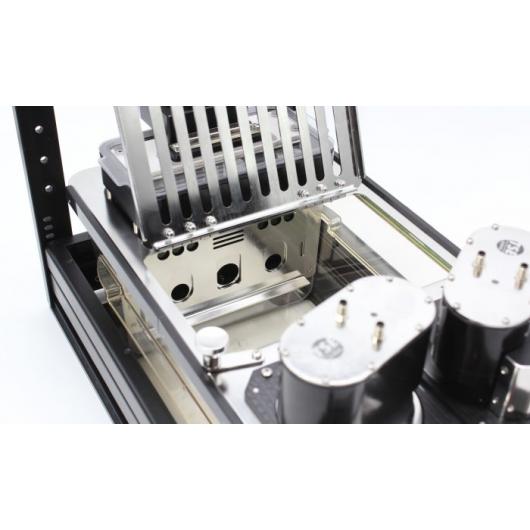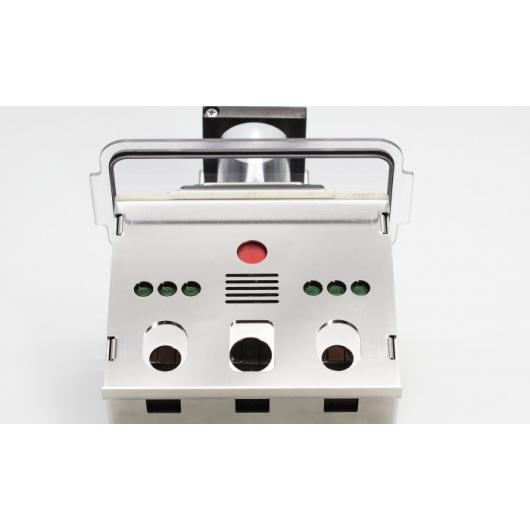


Operant wall
Features
- Cognitive testing in the home cage
- Minimal human interference
- Increased habituation and learning speed
- Long-term self-motivated learning
- Circadian screening of learning abilities
- Integration into a fully equipped PhenoMaster setup possible
- Customized test protocols with the powerful Operant Behavior software
- Reduced anxiety and stress level
Applications
- Cognitive Functions
- Phenotyping
Disease models
- Alzheimer´s
- Huntington´s
- Diabetes & Obesity
Compatible with
The TSE PhenoMaster system features the only integrated operant testing platform available on the market – the Operant Wall. Perform fully automated operant conditioning experiments without user interference – no stress for the animal that could interfere with learning performance and influence data output. The homecage setup allows long-term experiments with more trials per animal and facilitates circadian analysis of learning abilities. It also reduces the experimenter workload and saves laboratory space.
Operant Walls are available for rats and mice. They are configured from a variety of hardware modules such as levers, nose poke units, pellet, or liquid dispensers to meet the requirements of individual operant tasks. Whether you want to study motivation, attention, impulsivity, or run simple learning tasks – the system offers nearly unlimited flexibility in creating your Operant Conditioning experiments. The easy-to-use graphical user interface allows easy creation of custom protocols without the need for a programming background.
Interactive operation with other Phenomaster modules allows unprecedented flexibility in your experimental design. Use the Access Control Unit to restrict access to food before starting the operant test, therefore, increasing motivation to work for food. Combine an Operant Wall with a Voluntary Running Wheel to use wheel running as reinforcer or response element. The Operant Wall can even be integrated into a Calorimetry system.
Operant Wall setups can also be extended with components for optogenetic stimulation, fiber photometry, neural recordings, or infusion studies. TSE provides special cages/cage lids, Counterbalance arms, and TTL units for that purpose.
Sudakov S, Bogdanova N. Involvement of peripheral opioid receptors in the realization of food motivation into eating behavior. Front Behav Neurosci 2021; 14: 600920
Habermeyer J, Boyken J, Harrer J, Canneva F, Ratz V, Moceri S, Admard J, Casadei N, Jost G, Bäuerle T, Frenzel T, Schmitz C, Schütz G, Pietsch H, von Hörsten S. Comprehensive phenotyping revealed transient startle response reduction and histopathological gadolinium localization to perineuronal nets after gadodiamide administration in rats. Sci Rep 2020; 10(1): 22385
Delbès AS, Castel J, Denis RGP, Morel C, Quiñones M, Everard A, Cani PD, Massiera F, Luquet SH. Prebiotics Supplementation Impact on the Reinforcing and Motivational Aspect of Feeding. Front Endocrinol 2018; 9: 273
Plank AC, Canneva F, Raber KA, UrbachYK, Dobner J, Puchades M, Bjaalie JG, Gillmann C, Bäuerle T, Riess O, Nguyen HHP, von Hörsten S. Early Alterations in Operant Performance and Prominent Huntingtin Aggregation in a Congenic F344 Rat Line of the Classical CAGn51trunc Model of Huntington Disease. Front Neurosci 2018; 12: 11
Popova A, Tsvirkun D, Dolgov O, Anokhin K, Alberts J, Lagereva E, Custaud MA, Gauquelin-Koch G, Vinogradova O, Andreev-Andrievskiy A. Adaptation to a blood pressure telemetry system revealed by measures of activity, agility and operant learning in mice. J Pharmacol Toxicol Methods 2017; 85: 29-37



